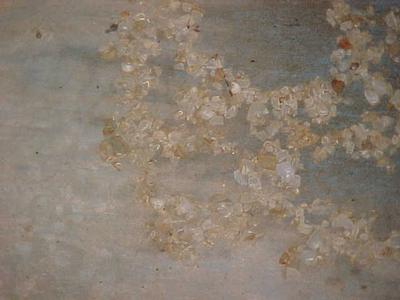
|
|
8 August, 2001
August 8, 2001
Two and a half days into Teachers Experiencing Antarctica and Arctic (TEA)
orientation and still attempting to pack new information into my little
brain. Sitting, listening, thinking, asking, wondering …. Yes, I have become
a student again!
Our meetings are being held at Cold Regions Research and Engineering
Laboratory (CRREL) at Hanover, NH. This afternoon, we had a break from our
chairs and an opportunity to tour the research facilities . Sitting on about
one square block of asphalt property are a variety of nondistinct, brick,
buildings, such as the Ice Testing, Frost Effects, Soils Recycling and
Geophysics Research Facilities. Inside each is a variety of research
equipment. None of it seems elaborate, though. Some consist of concrete
structures that look like swimming pools, one has five 50 m paths of gravel
or dirt, one is empty, and one has wooden channels built with sensors.
Although their appearance is simple, the research questions are complex.
CRREL scientists are testing how to prevent flooding as a result of river
freeze-up, how to improve the durability of asphalt highways that want to
buckle due to frost affects, and how to improve submarine sensors so they can
determine the height of waves found above.
One that especially caught my attention was research involving how fish
survive in river water with small ice pieces (frazil ice) – haven’t you ever
wondered how their gills could deal with these ice pieces … wouldn’t they get
caught in the gills and interfere with gas exchange? Oddly, they found that
the fish act as you would in a smoky room – you would hide behind a door to
avoid the majority of smoke and cough to remove the irritating smoke you do
breathe in. Similarly, the fish hide behind a rock to avoid most of the
frazil ice and even cough to get rid of the pieces that do enter! Maybe
there is more we could learn from these simple fish!
One of our tour guides, Len Zabiliansky, research civil engineer, CRREL,
said, "It is seat of the pants engineering taking place here. We begin with
what we know about basic science, brainstorm ideas of what may work, then try
them out." So science is really a continuous process, involving many
subjects, such as math, physics, chemistry, biology, geology, writing, and
the important skill of cooperation.
The basis of their ‘cutting edge research’ begins with making field
measurements, just as you or I would do during a lab. They then take these
observations/measurements back to the lab and build a smaller model of the
real thing. As they perform tests with their model, they collect more data.
Then comes the fun part – they input it into a designed mathematical model,
use the calculations to design a new product, such as a ship, and take this
new product back out into the field in order to make new observations –
starting the whole process over again! Does anyone recognize the scientific
method within the work?
A second observation I made was attention they paid to the little things when
doing their testing. For example, when they tried to model affects of frazil
ice, they cut up the balls from roll-on deodorants! Why? The material in
these actually has the same density and behavior (cohesion) that the frazil
ice exhibits!
Another example of remembering the details in experimental design was found
in their asphalt tests. They would lay down ground material to resemble that
of a geologic area they were testing (gravel, sand, mud or combinations),
freeze it, cover it with asphalt, then drive a type of ‘car’ called an
accelerated load cart, back and forth over the asphalt and measure stress and
observe breakdown. This ‘car’ didn’t look like any car we are familiar with
in Nebraska. It is actually a metal contraption weighing 1.8 tons set on top
of the asphalt. Only one part, found sort of in the belly area of the
machine, has wheels and moves back and forth as a car may. It not only moves
…. It MOVES so fast that it can put as much mileage on that test strip in 2
weeks that it would take a typical car to go in 2 years! The interesting
detail they remembered was to make this accelerated load cart follow a
slightly different path each time it passed the test area. Doesn’t this make
sense …. Not every vehicle on a highway drives the exact same path!
Finally, it was interesting to hear how failure really isn’t failure in
science. During a test run performed specifically for the media, a
constructed model of a device to stop the build-up of ice and subsequent
flooding COMPLETELY bombed. Because of the problems they did not foresee,
and the embarrassing breakdown, the actual structure to be placed in the
river was modified and is now successful.
Science is exciting! I am continually amazed by the questions some minds
ask, as well as the way they find the solutions. Although some great
findings seem to be luck, the science process was their lucky charm.
For tonight’s ending thought is a quote from a poster I read in the ‘cold
room’ area – “One test is worth a thousand expert opinions.”
Kim Hanisch
TEA – Arctic Regions
"The person that can make hard things easy is the educator."
--
"The person that can make hard things easy is the educator."
-Ralph Waldo Emerson

Imitation Frazil Ice made from cut up roll-on deoderant balls. -- "The person that can make hard things easy is the educator." -Ralph Waldo Emerson
Contact the TEA in the field at
.
If you cannot connect through your browser, copy the
TEA's e-mail address in the "To:" line of
your favorite e-mail package.
|
